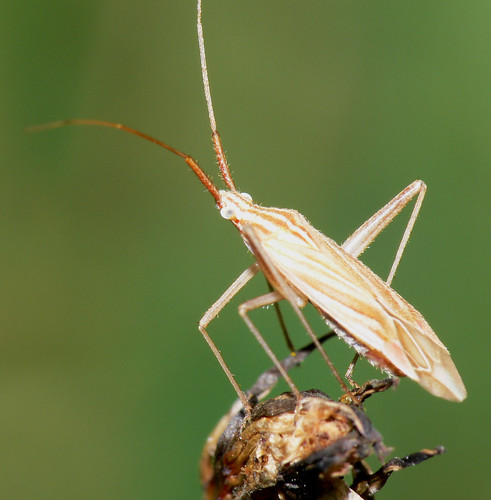 |
| Mirid bug. Photo from Flickr |
Field data collected in 2004, indicated that during the first six years of Bt-cotton seed planting, the initial benefits (reduced need for pesticides and increased income) had already been eroded by the need to control emerging secondary pests which the Bt toxin didn't kill. The scientists stated “Failure to find a solution, may lead to the discontinuation of the use of Bt-cotton seed in China and elsewhere”.
By 2010, 95% of cotton grown in China was GM. Chinese scientists reported that pesticide use on Bt crops had crept up from nil to two thirds of its pre-GM levels, and that this rise was anticipated to continue. A key problem noted by the authors of this study was that farmers are facing new pests, which they react to by overusing pesticides because information on the timing, dosage and frequency of chemicals appropriate to the new pests is not available. Chinese cotton farmers have no prior experience to fall back on, and scientists haven't yet been able to provide the knowledge they need.
Indeed, scientists have a lot of catching up to do in this field: the long-term effects of transgenic Bt crops on non-target pests have received limited attention, especially in the diverse small-holder cropping systems in the developing world.
The most problematic secondary pests to emerge on Bt cotton in China are mirid bugs (see below). Ten years of field trials in China have tracked a steady increase in these previously innocuous insects. This has happened because the heavily-sprayed cotton of the past which used to act as a sink for mirids and prevent them from destroying many other crops, has now become a source: mirids use the unsprayed GM cotton as a haven from which to spread to neighbouring fields.
Mirid bugs
Mirid bugs are herbivores which infest a wide range of crops including cotton, cereals, vegetables, and fruit. Historically mirid bugs in China were considered occasional or minor pests, only sporadically requiring management.
Mirids have, however, the potential to become major pests because of their ability to switch host crops, their fast growth rate, their strong dispersal capacity, and their environmental adaptability.
A study of Chinese farmers' experiences with Bt cotton published in 2011 found that a quarter of farmers reported reduced productivity, and two thirds reported no savings in costs due to the high price of Bt seed. More disturbing was the revelation that Chinese cotton farmers who have used the biotech seeds for a decade don't know the words “transgenic” nor “Bt”. Data on how Bt cotton effects both farmers and the environment are confounded by the huge trade in illegal Bt seed of unknown quality.
So far, scientists in China have been trying to develop multi-pronged solutions to the mirid bug problem, including defining the most effective way to use pesticides against them, growing crops the bugs prefer near to the GM cotton, and producing plants which will kill cotton bollworms and mirids.
One scientists stressed that pest control must keep sight of the whole ecosystem.
“The impact of genetically modified crops must be assessed on the landscape level, taking into account the ecological input of different organisms. This is the only way to ensure the sustainability of their application.”
OUR COMMENT
Inserting a single gene into a crop plant is simple. The effects of that one gene on the whole ecosystem around the crop are complex beyond our ability to grasp.
Inserting a single gene into a crop plant is simple. The effects of that one gene on the whole ecosystem around the crop are complex beyond our ability to grasp.
It seems the answers sought by scientists to the predictable emergence of secondary pests on Bt crops are more (expensive) chemicals, more (expensive) artificial genes, or paying the price of a sacrificial non-GM crop to preserve a GM one. None of these are sustainable.
More fundamentally, the underlying problem seems to be at the landscape level of the Chinese farmers: they're being sold high-tech seed without the resources needed to manage them, and their traditional skills are useless. Add to this that no matter how much technical information the scientists generate and pass on to the farmers, if rogue Bt seed is being planted this knowledge will likely be useless too.
Lack of control by the authorities in China may pose the biggest threat. When (not if) cotton seeds emerge containing health-damaging Bt-toxin variants, or with interacting combinations of Bt-toxins, their effects at the landscape level of the people and the environment will be catastrophic.
India is going through something very similar with mealy bug. Check out DEADLY GIFT – Archive news, March 2010.
SOURCES
- Shenghui Wang et al., 2008, Bt Cotton and Secondary Pests, International Journal of Biotechnology 10:2/3
- Yanhui Lu, et al., 2010, Mirid Bug Outbreaks inMultiple Crops correlated with Wide-Scale Adoption of Bt Cotton in China, Science 328, 28.05.10
- Jane Qui, 2010, GM crops use makes minor pests major problem, Nature online, 13.05.10
- Jennifer H. Zhao, et al., 2011, Benefits of Bt cotton counterbalanced by secondary pests?, Environmental Monitoring Assessment, 173
No comments:
Post a Comment
Thanks for your comment. All comments are moderated before they are published.